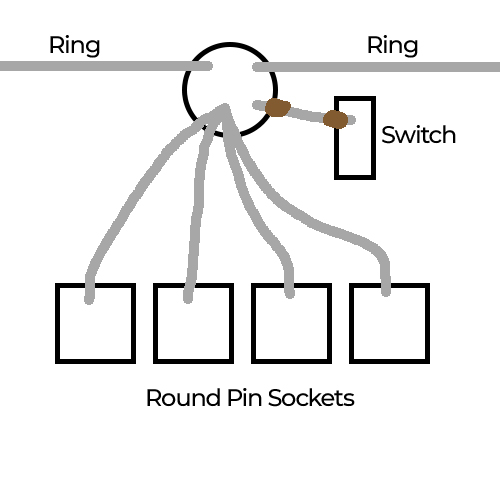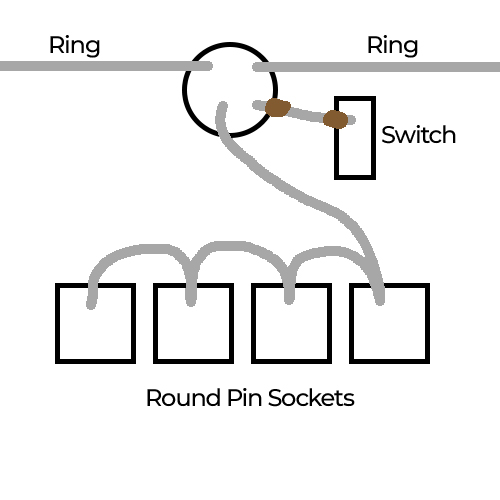I would get an electrician to do it, because the Wiring Regulations are prescriptive and can be complex. It also means he's chasing the walls (or fishing for cables behind plasterboard) and not me.
What I would anticipate the solution to be is based on your second option, although the switch is incorporated into the socket wiring. One reason for that is that it seems a reasonable way of getting power from the ring in the ceiling to the sockets on the skirting board. Another reason is that trying to get three additional cables into the ceiling rose as per Option A will typically be impossible.
Note: this is only a broad outline. I haven't checked the Regulations. Another reason for using an electrician.
As Graham Nye indicates, lighting circuits may not form a ring, but the lights are strung out along a single spur. This still means that at each ceiling rose (except the last), the mains supply comes in from the previous rose and goes out to the next one. It has the appearance of a ring.
The light switch is generally connected to the ring at the ceiling rose, with one core of the switch cable (brown) live and the other core (blue) switched. The blue core is then connected to the pendant light in the ceiling rose. You should also have an earth core which earths the screws in the switchplate.
To change from centre lighting to socketed lighting, the blue core to the switch needs to be connected to the neutral of the ring in the ceiling rose. You then have a standard live-neutral pair to the switch (with the earth core). That cable will probably be rated at 5A, and is protected by the 5A fuse in the lighting ring.
Install suitably-rated cable vertically down from the switch to a new unswitched fused connection unit at skirting level. From there, run cable horizontally around the skirting to sockets as desired. [You don't need a fused connector here, but it may make the job easier and the cable runs more obvious. You could simply use a single length from the switch to the first socket, with a right-angle bend where it turns along the skirting board.] You can get skirting board with a channel in the back for cable if that's easier. Cables can't run diagonally: they must run vertically or horizontally and if horizontal then that must be obvious.
Because this is run from the lighting circuit, the fuse in the connection unit (if you have one) needs to be appropriately-rated: the circuit fuse is 5A so there's no point having it larger. 3A should be ample, and lower ratings are available.
Using the existing cable between the ceiling rose and the switch means that the neutral core in that cable needs to be connected to the neutral core in the new cable. One easy way of doing that is to use a double-pole light switch (probably rated at 10A, and probably stiffer than a single-pole 5A switch).
If you anticipate installing a two-gang switch and adding lighting sockets to the existing centre light, then this method won't work because the cable from the rose to the switch can't function as both switched and supply. You'd need an additional supply cable from the ring. This method also won't work if the existing cable to the switch doesn't have an earth core, because the sockets must be earthed; the two-core cable will need to be replaced.


